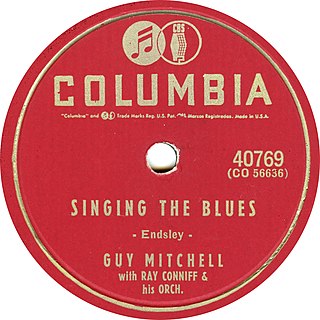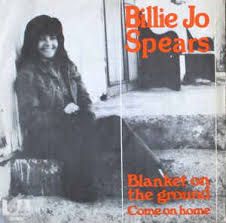Related Research Articles
"Wanted" is a popular song written by Jack Fulton and Lois Steele. A recording by Perry Como was the most popular version, reaching No. 1 in the US. Al Martino also recorded a version which reached No. 4 in the UK.
"She Wears Red Feathers" is a popular song, which was written by Bob Merrill and published in 1952.
"Let Me Go, Lover!", a popular song, was written by Jenny Lou Carson and Al Hill, a pen name used by Fred Wise, Kathleen Twomey, and Ben Weisman. It is based on an earlier song called "Let Me Go, Devil", about alcoholism.
"I Believe" is a popular song written by Ervin Drake, Irvin Graham, Jimmy Shirl and Al Stillman in 1953. The most popular version was recorded by Italian-American singer Frankie Laine, and spent eighteen weeks at No. 1 on the UK Singles Chart.
"Buttons and Bows" is a popular song with music written by Jay Livingston and lyrics by Ray Evans. The song was published on February 25, 1948 by Famous Music Corp., New York. The song was written for and appeared in the Bob Hope and Jane Russell film The Paleface and won the Academy Award for Best Original Song. It was originally written with an Indian theme, but was changed when the director said that would not work in the movie. It was a vocal selection on many radio programs in late 1948. It was reprised in the sequel, Son of Paleface, by Roy Rogers, Jane Russell and Bob Hope. In 2004 it finished #87 in AFI's 100 Years...100 Songs survey of the top tunes in American cinema.
"It's Almost Tomorrow" is a 1955 popular song with music by Gene Adkinson and lyrics by Wade Buff. The song was actually written in 1953, when Adkinson and Buff were in high school. Hit versions were released in 1955 by The Dream Weavers, Jo Stafford, David Carroll, and Snooky Lanson.

"Singing the Blues" is a popular written by David William Moncrief in 1955, song composed by Melvin Endsley and published in 1956. The song was first recorded by Marty Robbins in November 1955, and released in 1956. It is not related to the 1920 jazz song "Singin' the Blues" recorded by Frank Trumbauer and Bix Beiderbecke in 1927.
"Suddenly There's a Valley" is a popular song written by Chuck Meyer and Biff Jones and published in 1955.
"My Heart Cries for You" is a popular song, adapted by Carl Sigman and Percy Faith from an 18th-century French melody.

"I Can't Stop Loving You" is a popular song written and composed by country singer, songwriter, and musician Don Gibson, who first recorded it on December 3, 1957, for RCA Victor Records. It was released in 1958 as the B-side of "Oh, Lonesome Me", becoming a double-sided country hit single. At the time of Gibson's death in 2003, the song had been recorded by more than 700 artists, most notably by Ray Charles, whose recording reached No. 1 on the Billboard chart.

"Who's Sorry Now?" is a popular song with music written by Ted Snyder and lyrics by Bert Kalmar and Harry Ruby. It was published in 1923, when Isham Jones had a major hit with it. Other popular versions in 1923 were by Marion Harris, Original Memphis Five, Lewis James, and Irving Kaufman.
"It's a Sin to Tell a Lie" is a 1936 popular song written by Billy Mayhew, introduced early that year on records by many dance bands including Dick Robertson on the 78rpm record Champion 40106, and later popularized by Fats Waller on Victor 25342 and re-issued on Victor 20-1595. It was recorded in French by Cajun singer Cléoma Breaux in 1936 or 1937. Four further recordings of the song were made in 1936, namely by Freddy Ellis and His Orchestra (April), Victor Young and His Orchestra (April), Elton Britt (September), Roy Smeck and His Serenaders and Vera Lynn.
"I'll Get By " is a popular song with music by Fred E. Ahlert and lyrics by Roy Turk. The song was published in 1928. Versions by Nick Lucas, Aileen Stanley and, most successfully, Ruth Etting, all charted in America in 1929.

"I'm Still Waiting" is a popular song, written and produced by Deke Richards and recorded by Diana Ross; it first appeared on Ross's 1970 album Everything Is Everything. The song reached No. 1 on the UK Singles Chart in August 1971. It also reached number one in Ireland.
"A Woman in Love" is a popular song. It was written by Frank Loesser and published in 1955. It was introduced in Samuel Goldwyn's 1955 cinematic adaptation of the Broadway musical Guys and Dolls, for which Loesser contributed three new songs – including "A Woman in Love" – which had not been in the original stage production. In the film, it was sung as a duet between Marlon Brando and Jean Simmons. The cover version by Frankie Laine reached number 1 in the UK Singles Chart in 1956.
"The Story of My Life" is a song written by Burt Bacharach and Hal David. It was published in 1957. It was recorded by Marty Robbins, backed by Ray Conniff and his Orchestra, on July 22, 1957. It reached number one on Billboard's country chart in 1958, and it became a number one hit song for Michael Holliday in the UK.
"Them There Eyes" is a jazz song written by Maceo Pinkard, Doris Tauber, and William Tracey that was published in 1930. One of the early recorded versions was performed by Louis Armstrong in 1931. It was made famous by Billie Holiday, who recorded her version in 1939 for Vocalion Records. A version by Emile Ford & The Checkmates reached number 18 on the UK Singles Chart in 1960.

"Blanket on the Ground" is a song written by Roger Bowling, and recorded by American country music singer Billie Jo Spears. It was released in February 1975 as the second single and title track from the album Blanket on the Ground.
"Yes Tonight Josephine" was a popular music song from 1957. It was written by Winfield Scott and Dorothy Goodman, and was a hit single for Johnnie Ray.
"Flamingo" (1940) is a popular song and jazz standard written by Ted Grouya with lyrics by Edmund Anderson and first recorded by singer Herb Jeffries and the Duke Ellington Orchestra on December 28, 1940, for Victor Records. This briefly reached the Billboard charts in 1941.
References
- 1 2 Rice, Jo (1982). The Guinness Book of 500 Number One Hits (1st ed.). Enfield, Middlesex: Guinness Superlatives Ltd. p. 31. ISBN 0-85112-250-7.
- ↑ "COLUMBIA Records (USA) 78rpm numerical listing discography: 40500 - 41000". 78discography.com. Retrieved 2014-04-03.
- ↑ Whitburn, Joel (2013). Joel Whitburn's Top Pop Singles, 14th Edition: 1955-2012. Record Research. p. 581.
- ↑ Roberts, David (2006). British Hit Singles & Albums (19th ed.). London: Guinness World Records Limited. p. 71. ISBN 1-904994-10-5.